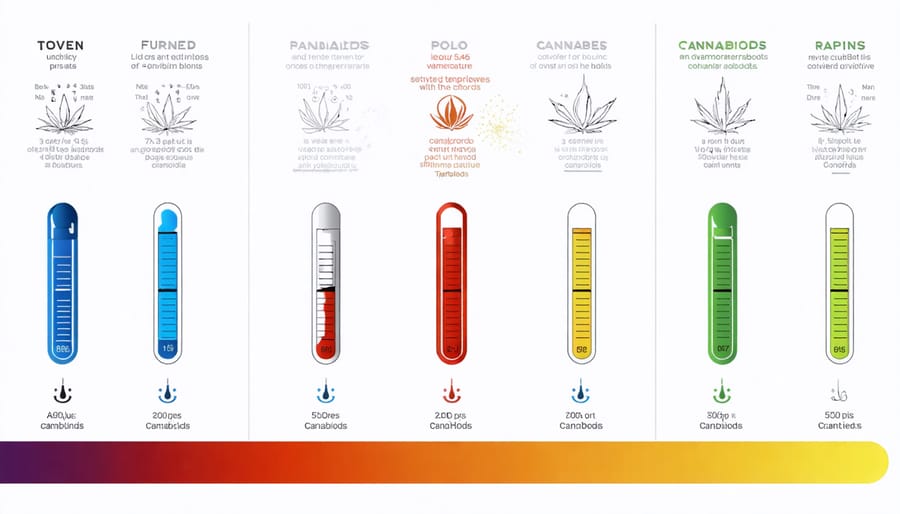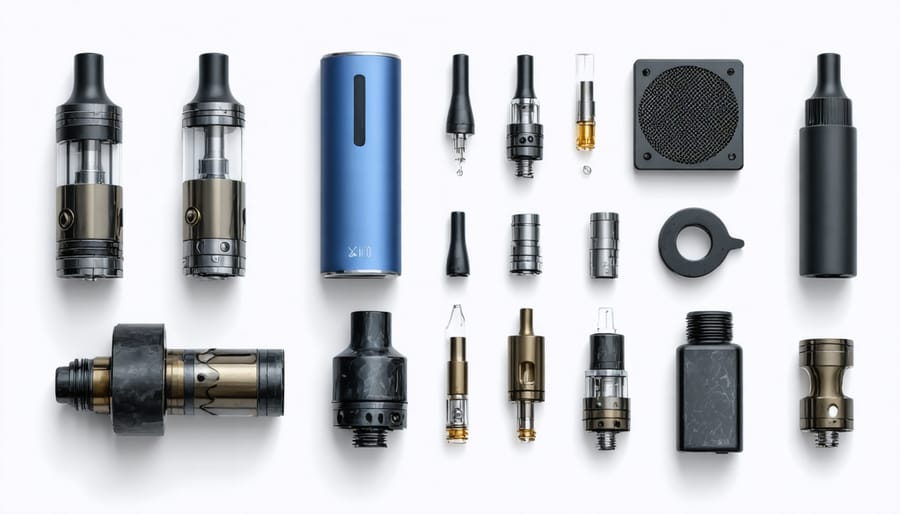Vaping cannabis has fundamentally transformed how millions consume THC and CBD, from sleek mango vape flavors to medical-grade concentrates. Yet as emergency room visits for vaping-related lung injuries rise and researchers uncover new evidence about respiratory impacts, the health implications demand closer examination. Recent studies reveal a complex picture: while vaporizing may reduce some risks associated with smoking, it introduces unique concerns about chemical exposure, device safety, and long-term effects on lung function. For both medical patients and recreational users, understanding these emerging health impacts has never been more crucial. This evidence-based exploration cuts through the hype and misinformation, examining what the latest research tells us about the real benefits and risks of cannabis vaping – from immediate physiological effects to potential long-term health consequences that every user should consider before choosing this increasingly popular consumption method.
The Science Behind Cannabis Vaping
Temperature Matters: Cannabinoid Activation Points
Temperature control is crucial when vaping cannabis, as different compounds activate at specific heat points. Understanding these THCA and THC differences and their activation temperatures can help you maximize both safety and effectiveness. Most cannabinoids begin to vaporize between 315°F and 440°F (157°C-227°C). At lower temperatures (315°F-330°F), you’ll experience milder effects with more flavorful terpenes and CBD activation. This range is ideal for daytime use and those seeking therapeutic benefits without intense psychoactive effects. Medium temperatures (330°F-370°F) strike a balance, activating THC while preserving beneficial compounds. This sweet spot delivers full-spectrum effects while minimizing potentially harmful byproducts. Higher temperatures (370°F-440°F) produce stronger effects but may compromise some of the more delicate compounds. Importantly, avoiding temperatures above 440°F prevents combustion and the formation of harmful compounds associated with smoking. Modern vaporizers with precise temperature controls allow users to customize their experience while maintaining safety standards.

Vaping vs. Smoking: The Chemical Breakdown
When comparing vaping and smoking cannabis, the chemical profiles reveal significant differences in both composition and exposure levels. While smoking creates combustion temperatures around 900°C (1652°F), vaping CBD oil effectively occurs at much lower temperatures, typically between 160-230°C (320-446°F). This temperature difference dramatically impacts the chemical byproducts users inhale. Smoking produces tar, carbon monoxide, and numerous carcinogenic compounds through combustion. In contrast, vaping creates fewer harmful byproducts while still effectively releasing the desired cannabinoids and terpenes. Research indicates that vaping can reduce exposure to toxic compounds by up to 95% compared to smoking, though it’s important to note that neither method is completely risk-free. The vapor produced contains primarily cannabinoids and terpenes, with significantly fewer particulates and harmful compounds than smoke. However, the quality of vaping products matters considerably. Licensed producers use regulated ingredients, while illicit market products may contain harmful additives or cutting agents that could pose serious health risks when heated and inhaled.

Short-Term Health Effects
Respiratory System Response
The respiratory system’s response to cannabis vaping presents a complex interplay of effects that users should understand. Unlike traditional smoking, vaping produces vapor instead of smoke, which many initially assumed would be less harmful to the lungs. However, recent research has revealed important considerations about how vaping impacts our breathing mechanisms. When cannabis vapor enters the lungs, it can cause immediate effects like coughing, throat irritation, and bronchial constriction. These reactions often vary based on factors such as vapor temperature, cannabinoid concentration, and individual sensitivity. Users experiencing significant discomfort should familiarize themselves with managing adverse effects to ensure a safer experience. The lungs’ natural protective mechanisms, including ciliary function and mucus production, can be temporarily altered by vaping. While these changes are generally less severe than with combustion methods, regular users may notice increased mucus production or mild respiratory irritation. It’s worth noting that the presence of terpenes and other cannabis compounds in vapor can influence how the respiratory system responds. Some users report improved breathing compared to smoking, while others experience heightened sensitivity. The quality of vaping devices and materials used plays a crucial role in respiratory health outcomes. Using regulated, high-quality vaping products and maintaining proper temperature control can help minimize potential respiratory stress while still achieving desired effects.
Cardiovascular Considerations
When it comes to the immediate cardiovascular effects of cannabis vaping, users often experience noticeable changes in heart rate and blood pressure within minutes of use. THC, the primary psychoactive compound in cannabis, typically causes an increase in heart rate by 20-50 beats per minute, which can last for several hours after use. This elevation is similar to what you might experience during light exercise. Blood pressure responses can be more complex and vary between individuals. Initially, many users experience a slight increase in blood pressure, followed by a decrease as the body adjusts to the compounds. For some people, this can result in feeling lightheaded or dizzy, especially when standing up quickly. These cardiovascular effects are particularly important for individuals with pre-existing heart conditions to consider. While most healthy adults can tolerate these temporary changes, those with heart disease, hypertension, or arrhythmias should exercise caution and consult healthcare providers before vaping cannabis. The method of consumption matters too. Vaping typically delivers cannabinoids more efficiently than traditional smoking, which means these cardiovascular effects can onset more quickly and potentially be more intense. The good news is that these effects are usually temporary and resolve as the cannabis leaves your system. For optimal safety, it’s recommended to start with lower doses and be mindful of your body’s response, especially if you’re new to cannabis vaping or have any cardiovascular concerns.
Long-Term Health Implications
Current Research Findings
Recent studies have revealed complex findings regarding the long-term health impacts of cannabis vaping. A 2023 Johns Hopkins University study tracking 1,000 participants over three years found that vaping cannabis produced fewer respiratory symptoms compared to traditional smoking methods. However, researchers noted the need for more extended studies to fully understand potential lung health implications. The American Journal of Respiratory Medicine published findings indicating that while vaping reduces exposure to combustion-related toxins, it may present unique risks. Users reported experiencing different effects from vaping concentrates versus flower, with concentrate users showing higher rates of tolerance development and potential dependency. Particularly noteworthy is research from the University of California, which identified specific vaping-related compounds that warrant further investigation. Their 2022 study revealed that heating certain terpenes at high temperatures could produce previously unknown byproducts, though their health impacts remain unclear. Youth-focused studies have raised concerns about the increasing popularity of vaping among younger users, with researchers emphasizing the importance of age restrictions and education. However, for adult users, current evidence suggests vaping may offer a harm reduction alternative to smoking, though not without its own set of considerations. Experts stress that while preliminary findings are promising in terms of reduced respiratory impact, more longitudinal research is needed to fully understand the long-term effects of cannabis vaping on public health.
Areas of Ongoing Investigation
Despite the growing popularity of cannabis vaping, researchers acknowledge several critical areas that require further investigation. Scientists are currently exploring the long-term respiratory effects of vaping cannabis, particularly focusing on how different temperatures and extraction methods might influence health outcomes. One pressing area of study involves the interaction between various terpenes and cannabinoids when vaporized, as these compounds may behave differently under heat compared to traditional consumption methods. Researchers are particularly interested in understanding how these interactions might affect both therapeutic benefits and potential risks. The impact of different device types and materials on user health remains under investigation, with ongoing studies examining the role of heating elements, battery quality, and cartridge materials in vapor production and safety. Scientists are also conducting longitudinal studies to better understand how regular cannabis vaping might affect cardiovascular health and immune system function over time. Another crucial area of research focuses on comparing the health impacts of vaping cannabis versus smoking or other consumption methods. While preliminary evidence suggests vaping may be less harmful than smoking, researchers are working to quantify these differences and identify any unique risks specific to vaping. Additionally, studies are underway to examine the potential effects of cannabis vaping on youth brain development and mental health, as well as investigating the most effective harm reduction strategies for different user populations.
Safety Considerations and Best Practices
Quality Control: What to Look For
When selecting vaping products, prioritize devices and cartridges from licensed manufacturers who provide detailed ingredient lists and lab testing results. Look for products that use high-quality materials like medical-grade stainless steel, ceramic, or glass for heating elements and vapor paths. Avoid devices with plastic components that could leach harmful chemicals when heated. Check for third-party lab testing certificates that verify the absence of harmful contaminants like heavy metals, pesticides, and residual solvents. Quality cartridges should list their exact cannabinoid content and terpene profiles. Be wary of products with artificial flavoring agents or cutting agents like vitamin E acetate, which has been linked to serious lung injuries. The device itself should have consistent temperature control and safety features like automatic shutoff. Reputable manufacturers will provide clear operating instructions and maintenance guidelines. Consider devices with adjustable settings that allow you to control your intake and customize your experience. Remember that legitimate products will have proper packaging with batch numbers, manufacturing dates, and QR codes linking to lab results. If the price seems too good to be true, it probably is – investing in quality equipment is essential for your health and safety.

Risk Reduction Strategies
While complete elimination of risks isn’t possible, implementing smart vaping practices can significantly reduce potential health impacts. Start by purchasing only from licensed dispensaries and avoiding black market products, which may contain harmful additives. Maintain your vaping device properly by regularly cleaning components and replacing coils as recommended by manufacturers. Control your intake by starting with lower temperatures and taking shorter draws to minimize irritation. Consider implementing periodic cannabis tolerance management breaks to maintain effectiveness while reducing dependency risks. When vaping, ensure proper ventilation and avoid sharing devices to prevent potential transmission of infections. Choose devices with temperature control features and stick to middle-range settings (350-380°F) to avoid combustion while maintaining effectiveness. Keep track of your consumption patterns and listen to your body’s signals. If you experience persistent coughing or throat irritation, consider adjusting your technique or taking a break. Remember to store both your device and cannabis products in a cool, dry place away from direct sunlight to prevent degradation and maintain quality. As we’ve explored throughout this article, the relationship between cannabis vaping and health impacts is complex and continually evolving. The research presents both potential benefits and risks that deserve careful consideration. While vaping may offer a smoke-free alternative with potentially reduced respiratory irritation compared to traditional smoking, it’s not without its challenges, particularly regarding unknown long-term effects and quality control issues. The evidence suggests that responsible cannabis vaping, especially with verified products from licensed dispensaries, can be part of a harm reduction approach. However, the importance of making informed decisions cannot be overstated. Users should remain vigilant about product sources, understand the significance of temperature control, and stay informed about emerging research and regulations. As cannabis policy continues to evolve and new studies emerge, it’s crucial to approach cannabis vaping with a balanced perspective. Consider your personal health circumstances, consult healthcare providers when necessary, and stay educated about both the benefits and risks. Remember that what works for one person may not work for another, and there’s no one-size-fits-all approach to cannabis consumption. Moving forward, supporting further research and maintaining open dialogue about cannabis vaping will be essential for developing better understanding and safer practices. Whether you’re a current user, considering vaping, or simply staying informed, let evidence-based information guide your decisions while remaining mindful of your personal health and wellness goals.
